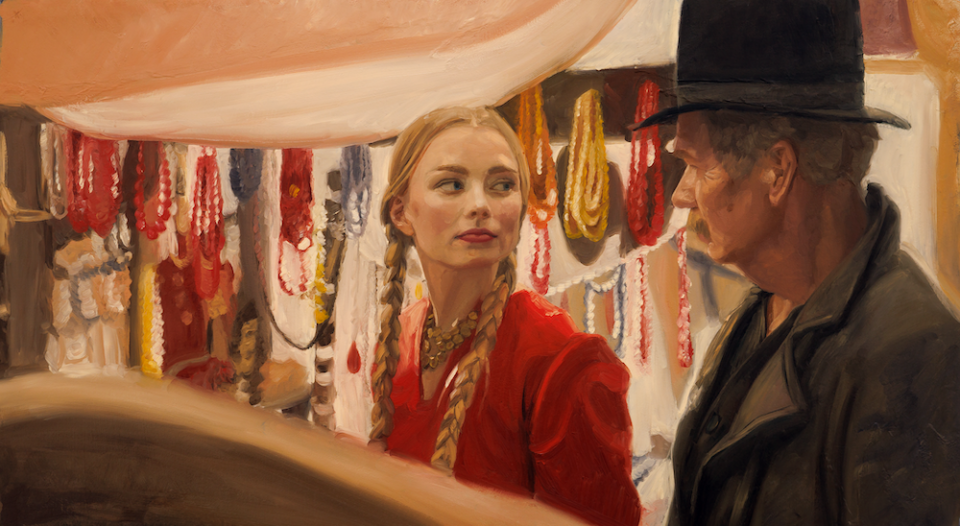‘The Peasants’ Review: The ‘Loving Vincent’ Directors Return with a Ravishing Animated Triumph

- Oops!Something went wrong.Please try again later.
- Oops!Something went wrong.Please try again later.

Editor’s note: This review was originally published at the 2023 Toronto International Film Festival. Sony Pictures Classics releases the film in select theaters on Friday, December 8.
Here’s the best kind of cinematic double down: One that doesn’t just repeat a past triumph, but goes deeper.
More from IndieWire
“Loving Vincent” was a dreamy plunge into the art of Vincent Van Gogh, which directors D.K. Welchman and Hugh Welchman created via tens of thousands of oil paintings, each frame of the animated film a full-size work on canvas you could hang on a wall. They’ve said that they’re always asked, “When are we getting ‘Loving Vincent II’?” As in, another animated film about another artist rendered in that artist’s style.
Instead, the wife-and-husband directorial team swerved and delivered something infinitely more ambitious, if commercially more challenging. Their long-awaited follow-up is “The Peasants,” a sensuous, richly immersive adaptation of Nobel laureate Wladislaw Reymont’s early 20th-century novel about life in a rural Polish village. D.K. Welchman is Polish (“Loving Vincent” is technically the highest-grossing Polish film of all time at the international box office), and she reconnected with Reymont’s novel while listening to it on audiobook when she was creating oil paintings for the previous film. And yes, “The Peasants” is also an animated work, with actors filmed in live action and then 40,000 oil paintings created on top of the photographic images.
It’s both exactly what you’d expect as the follow-up to “Loving Vincent” and nothing at all what you’d expect. In going from a film about the best-known artist of all time to an obscure literary adaptation, what the Welchmans have done would be the equivalent of, say, Baz Lurhmann deciding to follow up “Elvis” with an adaptation of a novel by Australian laureate Patrick White. (Which maybe he should do!)
Where “Loving Vincent” was a soothing experience, quiet and contemplative, “The Peasants” is loud and brash — powered by an extraordinary explosion of Polish folk songs given propulsive 21st-century beats by rapper/composer Lukasz “L.U.C.” Rostkowski — and, it must be said, deeply upsetting. It’s the story of Jagna, played with radiant energy by Kamila Urzedowska, whose defining feature is that she’s the most beautiful girl in her small village, Lipce. Well, that’s how everyone in Lipce defines her, at least. If they looked closer, they’d see someone who’s also a talented artist, who creates intricately refined paper cutouts and cares about animals (she takes on the project of rehabilitating an injured stork). What unfolds is a story about the tragedy of having others define who you are — as remote as this 19th-century village in Poland may seem, that is a theme that remains ever-potent.
Jagna’s in her late teenage years and lives with her mother. Because of her beauty, the townsfolk assume she must be sexually voracious and pursuing every man around, married or unmarried. There is little evidence that this is the case, though she does embark on an affair with a married man a few years older than her, Antek (Robert Gulaczyk). It’s a pure eruption of lust, her initial encounter with Antek being a moment of electric connection during a rainstorm when they’re working together to bring in the crops. Their initial coupling is staged with melodic grace, as Antek twirls her in a little dance before they rip each other’s clothes off. If making an animated film entirely out of oil paintings resulted in slightly static set-ups in “Loving Vincent,” “The Peasants” achieves a whole new level of dynamism — this time the frame itself moves, sometimes with a virtuosity you’d expect from only CGI animation, and at a moment like Jagna and Antek’s tryst, the camera feels like a participant, not a voyeur. There’s real intimacy here.
Antek is married, of course, so there’s an inherent limit to their relationship. And soon Jagna is encouraged to marry — to Antek’s dismay, to his own father, Boryna (Miroslaw Baka), the richest farmer in the village and a man very determined not to give any of his son’s inheritance to him until he’s in the grave. Their wedding is by turns solemn — L.U.C.’s arrangement of a chant by the female members of the wedding party sounds like something from a requiem mass — and then rambunctious as another dance scene whirls out of control, becoming so “you are there” immersive there are even subjective shots from the points of view of the dancers.
Of course, Jagna is going to continue her affair with Antek even after she’s married Antek’s father, and, needless to say, things do not go well. There’s something so elemental here in the way that you have a frosty landscape during the winter where Antek and Jagna hook up inside a hay bale — and then Boryna sets the bale on fire with them in it. That the painters the Welchmans marshaled to bring this to life were located in four different countries — Poland, Lithuania, Serbia, and Ukraine, where the war began as production was still ongoing — is a triumph of remote production. It all seems seamless. And, yes, there is a little bit of “Loving Vincent II” here, in the replication of paintings by several Polish artists: Ferdynand Ruszczyc, Michał Gorstkin-Wywiórski, and Józef Chełmoński, whose 1891 work “Partridges in the Snow” is entirely recreated in one moment.

As the downward trajectory of the story continues, it’s easy to be reminded of David Lean’s “Ryan’s Daughter” as another tale of a misunderstood woman in a rural community that ultimately rejects her with shocking, brutal force. That film famously polarized many — Pauline Kael and Richard Shickel being among its most myopic critics — and it’s hard not to think it’s because it involved the kind of unresolvable emotions common to great literature but harder to achieve in cinema. “The Peasants” operates in similar territory, and the sheer emotion it elicits by the end may be too much for some viewers to bear.
But it’s so worth the journey. Bringing this 1,000-page novel to animated life in this way isn’t just an adaptation, it’s an illumination. It makes real the heightened reality that exists in your mind when reading a particularly captivating book. The oil paint carefully applied over the faces of the actors doesn’t obscure them, but unleashes them to even more expressive ends: Urzedowska is indeed beautiful as Jagna, but with this approach it’s like her beauty radiates off her surroundings, all the better to appreciate why the villagers find her to be a disruptive presence even as you’re horrified by their response. In the Welchmans’ heightened reality, the screen is like the reflection in the glassy surface of a pond, the ripples the brushstrokes of their artists. There are deeper truths unlocked here than straightforward realism could provide.
There’s a lot of handwringing right now about “what’s next for cinema?” How can this medium evolve? What the Welchmans have achieved here is worth a look for the answers to those questions. Film has always been a voracious medium, hungrily eating up aspects of the other arts and combining them to form something new; “The Peasants” is of that tradition, not just fusing live-action and animation, but evolving painting itself toward new cinematic ends. Maybe the future of the medium is not in the invention of endless new technology or adorning yourself with headsets, but in ever more inventive excavations of the existing arts. After all, this is also a story that, superficially, seems far removed from contemporary life, but is about upward mobility, sexual liberation, and a misogyny expressed through public shaming — where the shtetl meets social media. Even down to how it iterates on “Loving Vincent,” “The Peasants” suggests the best path forward is the one that builds on, and what understands, what came before.
Grade: A
“The Peasants” premiered at the 2023 Toronto International Film Festival.
Best of IndieWire
Sign up for Indiewire's Newsletter. For the latest news, follow us on Facebook, Twitter, and Instagram.

